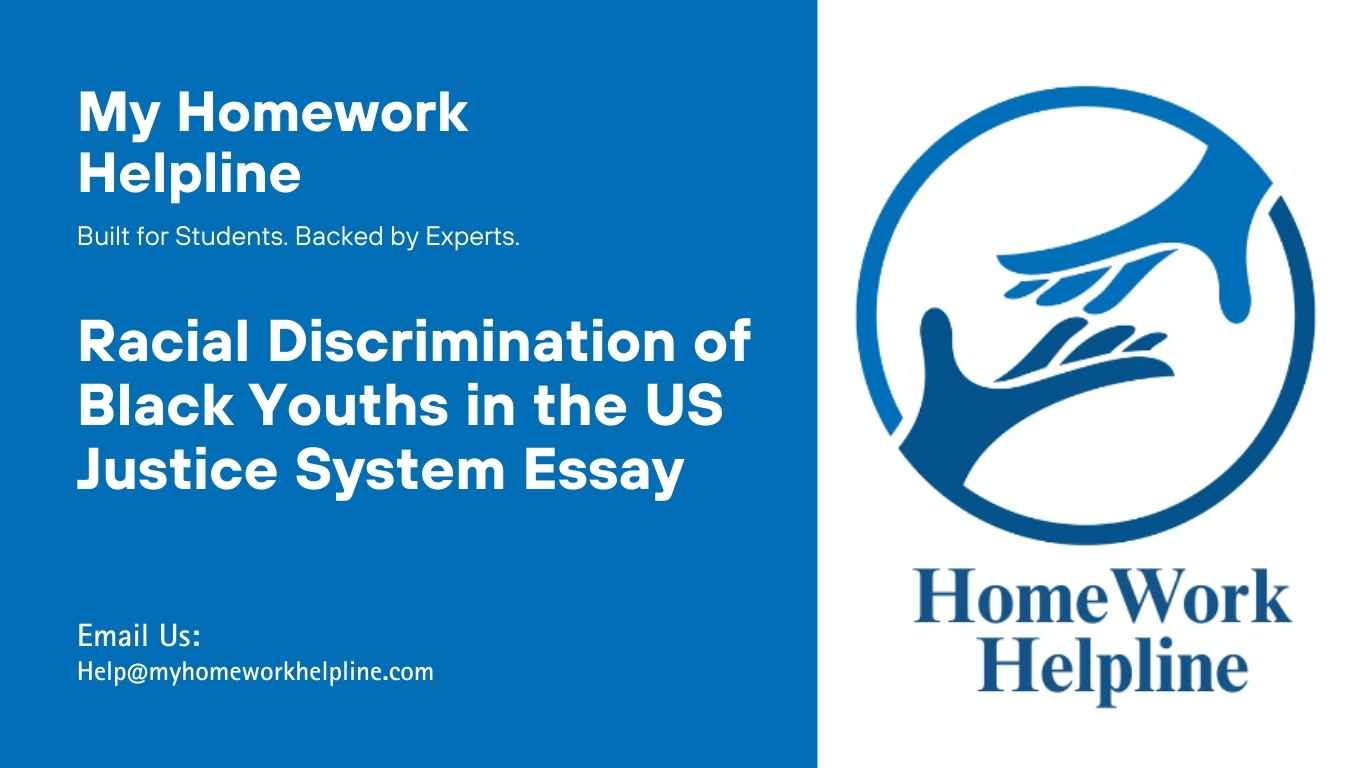The American Criminal Justice System and Racial Discrimination of Black Youths Argumentative Essay
Introduction
Black Americans are over represented in the nation’s justice system. While black men comprise 13% of the male population in the nation, they make up an estimate 35% of the jail population (Kurlychek & Johnson, 2019). According to Visano (2017), one in three African Americans are expected to go to jail in their lifetime, when compared to one in six Latino malmalesnd only one in 17 white males. Additionally, one in 18 black women born in 2001 is likely to go to jail in their lifetime, compared to 1 in 111 white women. Visano explains that the primary reason leading to disproportionate racial representation in American jails is the American history and is encouraged by the current practices in the justice system (Mauer, 2018). This paper aims to examine how racism in the criminal justice system leads to the mass incarceration of black people in America, particularly youths. I believe that even though youth crime has reduced, the rate of black youth incarceration in America is still high; thus the need for reforms to encourage better expression of power and cultural control.
Struggling to understand the complexities of racial discrimination in the American criminal justice system? Our sociology essay support on racial discrimination of Black youths provides comprehensive guidance, helping you tackle assignments, essays, and research papers effectively. With expert insights and structured explanations, you can improve your analysis, ensure accuracy, and meet academic standards. Gain reliable homework assistance and achieve higher grades with our professional support tailored to sociology topics.
Criminal Justice System Analysis
Tough on crime and American mass incarceration has fallen unequally on all Americans. Present day disparity depict the burden of mass incarceration unfairly burdening black people (Mauer, 2018). Even though the disparities have declined over the recent past, there still exists a substantial gap between the rates of incarceration of black and white youths. Black people representation in the American justice system is unwarranted given their population share. According to Visano (2017), the racial disparity in mass incarceration in America is not an accident, but rather it is rooted on the history of discriminatory and oppressive decision making that have intentionally targeted black people and assisted in the creation of an inaccurate image of crime that deceptively connects black people with criminality. Black people in America have historically been the target of discriminatory laws which are compounded by racial biases. Research shows that these laws exists in individual actors across the American justice system ranging from prosecutors and police to juries and judges (Kurlychek & Johnson, 2019). This has led to disproportionate levels of stops, arrests, searches, harsh plea bargain, detention of black people, and harsher sentencing outcomes in comparison to similarly situated white people. Underlying all these are systemic and deep inequalities that have led in significant numbers of black people in America living in poor, overpoliced communities, surrounded by educational and economic disadvantage, which are known factors that fuel criminal behavior (Mauer, 2018). This leads in a tenacious cycle of criminal justice discrimination for an overwhelming number of black individuals and their families.
Historically black people have been targets of intentionally discriminating laws. Racial disparities in the US have deep roots in the nation’s history and penal policy (Visano, 2017). After the emancipation, particularly in the South, black Americans were targets of particular forms of sentencing, policy, and confinement. The new laws took advantage of the 13th Amendment loophole that claimed citizens cannot be enslaved unless they are convicted of a crime. This was to target the newly emancipated African Americans as a means of exploiting their labor and surveilling them. According to Hinton et al. (2018), in 1865 and 1866, new set of laws were quickly enacted known as the Black Codes, by the former Confederate legislature, with the intention to force former slaves back into the exploitative labor system that mirrored the plantation structure. Although the new legislation recognized the legal status of black individuals, they were not allowed to vote, testify in court, or serve on juries. Vagrancy laws stated that individuals who could not prove that they worked for a white employer would be arrested. Historians explain that people arrested through these laws were subjected to a system of incarceration provided by private industries (Hinton et al., 2018). The system was referred to as convicting leasing, which allowed slavery for people who had been convicted of a crime ranging from walking at night or walking without purpose. North States also enacted policies that while they did not legally target African Americans they exerted social control over black Americans. These include enactment of laws against suspicious characters, keeping and visiting disorderly houses, disorderly conduct, violation of city ordinances, and drunkenness (Visano, 2017). This laws encouraged everyday surveillance and punishment of black people’s lives in the Midwest, West, and Northeast. Even though these laws were based on racist policies, they were used to link black people and crime.
Research shows that the incarceration of black Americans is particularly based on racist polices. A study conducted in 2010 established that Caucasian Americans overestimate the share of illegal drug sale, burglaries, and juvenile crime committed by black people with an estimate 20 to 30% (Kurlychek & Johnson, 2019). Statistics that are linked to people and crime over the course of the US history have overstated the issue of crime in African American communities and therefore producing a skewed depiction of American crime.
Bias by system actors have encouraged mass incarceration of African Americans. According to Kurlychek & Johnson (2019), beyond laws and policies, the bias of individual actors including judges, police, juries, and prosecutors in the criminal justice can encourage bias against black youths leading to more frequent arrest and incarceration of the minorities. For instance, a research shows that police are more likely to stop, search, and arrest African Americans. Another research showed that police are more likely to profile black youths as criminals compared to white youths. Prosecutor bias can result into harsher outcomes for black individuals. Prosecutors play an essential role in the criminal justice system as they directly influence the charging and plea bargain. Research shows that federal prosecutors are more likely to charge black individuals than their white counterparts who have commented similar offences. According to Visano (2017), Caucasian youths are 75% more likely to see their misdemeanor charges dismissed, dropped, or amended to lesser charges when compared to black youths. The result of such disparity against black people is; more black people being convicted and sentenced to jail time than white people. Judicial bias has the potential to result in worse criminal justice against African American youths (Mauer, 2018). Research carried out shows that judges are more determined to be fair when the accused is black. Since judges play a central role in the criminal justice their bias can result into harsher outcomes from pretrial detention to sentencing for any black youth. Jury biased has resulted in high incarceration of black individuals. Studies have shown that there is implicit jury bias and the defendant’s race (Visano, 2017). Therefore, juries are more likely to render individuals of a different race guilty verdict and longer jail time, and more leniency to their own race.
The criminal justice racial bias highly impact youth crime in the US. According to Visano (2017), African American youths are five times more likely to be incarcerated compared to white youths. From 2001 to 2015, juvenile incarceration in the US fell by 54%; however, incarceration of white youths fell faster than that of black youths. The national rate of youth incarceration in the US is 152 per 100,000; with Black youth incarceration rate being 433 per 100,000 when compared to 86 per 100,000 for white youth. The racial disparity between Black and White youths has increased by 22% since 2001. Young black men are three times more likely to be arrested for selling or using of drugs than their white counterparts. In 2003 to 2013 the rate of African American youths in jail grew from 38% to 48%. However, over the recent past the share of youth crime in the US have decline significantly therefore reducing the number of youth incarceration. The decline in number of incarceration can be attributed to the reforms in state and federal laws (Visano, 2017). The decline in incarceration of youths, however, is not proportionate by race. Thus, there needs to be better reforms that would ensure black youths in America receive fair treatment as their white counter parts.
Federal and state laws that particularly target black people in America should be reversed. According to Visano (2017), the racial disparity observed in the justice system ends up wasting resources in the criminal justice that could be used in other essential aspects. Researchers note that reversing mass incarceration policies to reduce the number of people in jail does not particularly result in reduction of racial bias in the judicial system. For instance, New Jersey reversed its state laws that resulted in decline by 26% of state prison population between 1999 and 2012. However, another research conducted recently established that black people in the region are still 12 times more likely to be imprisoned than white people. Therefore, the reforms should focus on correcting policies that particular impact people of color. State and local governments should reform law enforcement practices that will see the reduction in overpolicing of black communities and encourage community approaches instead (Visano, 2017). Additionally, governments should invest more in these neighborhoods through education and financial investments. Authorities can reject unfair practices that target poor minorities such as pretrial money bail (Kurlychek & Johnson, 2019). The authorities can also examine and reform legislations that may seem neutral but lead to disparate outcomes, such as discriminatory gang sentencing enhancement, risk-assessment tools, or geography-based school zone drug penalties. The private sector has a role to play in ensuring that people leaving jail have a place to access housing and employment, particularly young African American. These reforms will not only ensure reduction in mass incarceration of youths but also a reduction in percentage of black youths in prison.
Conclusion
The American justice system is biased against black people. While there has been major reforms to ensure black people enjoy similar freedoms as Caucasian Americans, the judicial system is still racist. The rate of incarceration of black people is still high when compared to their white counterparts. Thus, even with the reduction in youth crime in America, black youths are still more likely to be stopped, arrested, convicted, and even receive harsher punishments (Kurlychek & Johnson, 2019). Therefore, there is need to reform the judicial system to encourage better expression of power and cultural control. This will enable more youths to go to school and thus a reduction in crime. Additionally, it will ensure states reduce over spending on unnecessary activities that are racial motivated.
References
Hinton, E., Henderson, L., & Reed, C. (2018). An unjust burden: The disparate treatment of Black Americans in the criminal justice system. Vera Institute of Justice, 1-20.
Kurlychek, M. C., & Johnson, B. D. (2019). Cumulative disadvantage in the American criminal justice system. Annual Review of Criminology, 2(1), 291-319.
Mauer, M. (2018). The Crisis of the Young African American Male and the Criminal Justice System 1. In Impacts of incarceration on the African American family (pp. 199-218). Routledge.
Visano, L.A., (2017) Offended and Offending: Understanding Youth Crime Paperback (Second Edition)

